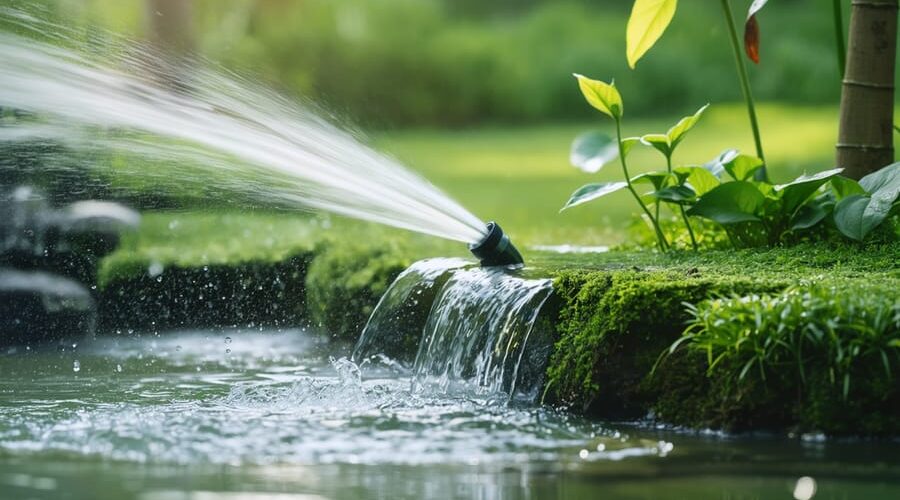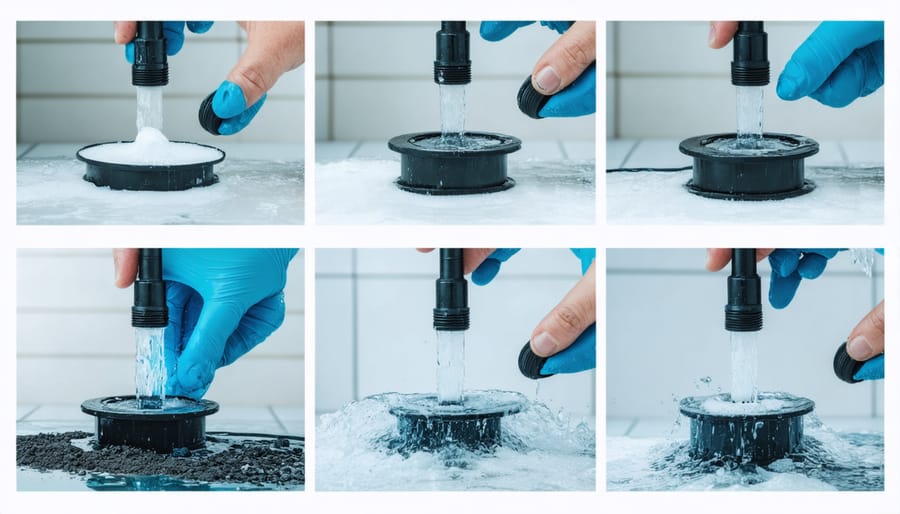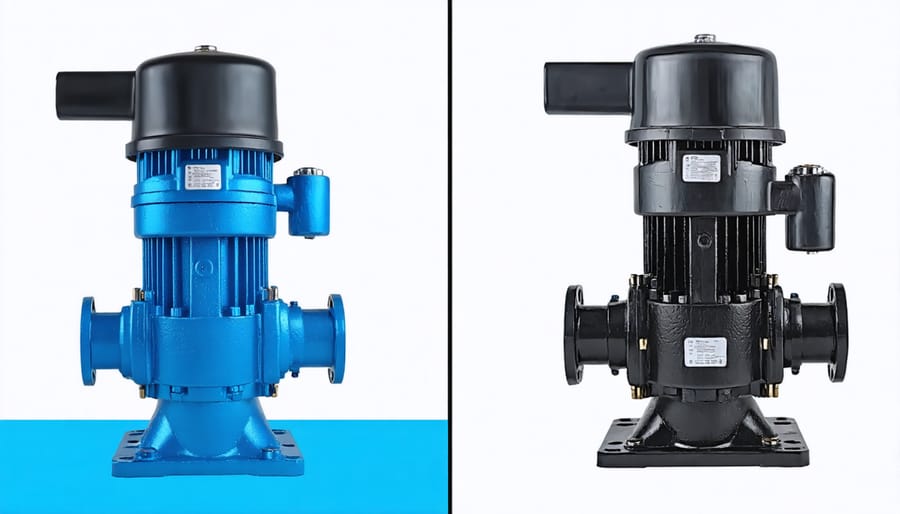
Keep Your Pond Pumping: Essential Irrigation Pump Care Made Simple
Maintain your irrigation pump’s peak performance through a consistent maintenance routine and proper pump operation. Regular inspection of seals, bearings, and impellers prevents costly breakdowns and extends equipment life. Clean intake screens monthly to prevent debris buildup and ensure optimal water flow. Monitor unusual sounds, reduced water pressure, or irregular operation – these early warning signs demand immediate attention to avoid system failure. Understanding your pump’s maintenance needs isn’t just about preventing problems; it’s about maximizing efficiency and protecting your investment in your irrigation system. Whether you’re managing a small garden setup or a large agricultural operation, these fundamental maintenance practices remain crucial for sustainable water management and reliable system performance.
Signs Your Irrigation Pump Needs Attention

Performance Warning Signs
Your irrigation pump will often tell you when it needs attention through various changes in performance. Keep an eye out for decreased water flow, which might start as a subtle reduction in fountain height or stream strength. Unusual noises, such as grinding, whining, or rattling, are clear indicators that something’s not quite right. If your pump starts making these sounds, don’t ignore them!
Watch for water pressure fluctuations – if your sprinklers or fountains are sputtering or delivering uneven flow, your pump likely needs maintenance. An overheating pump is another red flag, which you might notice if the motor housing feels unusually hot to the touch. Excessive vibration, higher electricity bills, or the pump frequently shutting off are also warning signs you shouldn’t ignore.
Remember, addressing these issues early can prevent more serious problems and extend your pump’s lifespan. If you notice any of these signs, it’s time to check your pump’s condition.
Strange Sounds and Vibrations
Your irrigation pump should operate with a steady, quiet hum. If you notice unusual sounds like grinding, screeching, or rattling, it’s time to investigate. These noises often signal problems that need immediate attention. A grinding sound typically means debris is caught in the impeller, while a high-pitched whine could indicate bearing failure.
Pay attention to vibrations too. While some vibration is normal, excessive shaking or wobbling isn’t. This could mean your pump isn’t properly mounted, or internal components are wearing out. If you notice the pump housing getting unusually hot or the motor making clicking sounds, shut it down immediately.
Listen for changes in the pump’s normal operating sound. A gurgling or sucking noise might indicate air in the system or low water levels. Sudden loud noises or complete silence are red flags that require immediate inspection. Remember, catching these issues early can prevent costly repairs down the line.
Regular Maintenance Schedule
Weekly Check-ups
Taking just 15 minutes each week for a quick pump check can prevent major issues down the line. Start by listening to your pump while it’s running – any unusual sounds like grinding or rattling need attention. Next, check the water flow rate by observing your fountain or waterfall output. If it seems weaker than usual, this could indicate a developing problem.
Inspect the pump’s exterior for any visible damage or debris buildup. Look for leaves, twigs, or other materials that might have gotten caught in the intake. Make sure all connections are tight and there are no visible leaks around the fittings or hoses.
Check your filter media if your pump has one – it should be free from excessive debris. Also, monitor the water level in your pond or reservoir, as running a pump with low water can cause damage.
Finally, feel the pump housing – it should be warm but not hot to touch. If it’s running unusually hot, this could signal overworking or potential failure. Keep a simple maintenance log to track these weekly observations, making it easier to spot developing issues early.
Monthly Deep Clean
Once a month, set aside time for a thorough deep clean of your irrigation pump to ensure optimal performance and longevity. Start by disconnecting the power and removing the pump from your water feature. Disassemble the pump according to the manufacturer’s guidelines, typically involving removing the intake screen and impeller housing.
Use a soft brush and mild soap solution to clean all components, paying special attention to the impeller and its housing. Remove any built-up algae, debris, or mineral deposits. For stubborn calcium buildup, soak affected parts in a solution of equal parts white vinegar and water for about 30 minutes.
Inspect all O-rings and gaskets for wear or damage, replacing them if necessary. Check the impeller for signs of damage or excessive wear. Clean the intake screen thoroughly and examine it for tears or holes that might allow debris to enter the pump.
Before reassembly, ensure all parts are completely dry. Apply a thin layer of silicone lubricant to O-rings and gaskets to prevent premature wear. Reassemble the pump carefully, making sure all components fit snugly together. This monthly ritual will significantly extend your pump’s lifespan and maintain its efficiency.

Seasonal Maintenance
Each season brings unique challenges for your irrigation pump, requiring specific maintenance tasks. In spring, clean debris from the pump and check for winter damage. Summer demands regular cleaning of filters and strainers to prevent clogs from increased organic matter. Monitor water levels closely during hot weather to avoid pump strain.
Fall maintenance focuses on removing fallen leaves and preparing for colder months ahead. Winterizing your pump system is crucial to prevent freeze damage. If you live in a cold climate, either remove the pump entirely or ensure it continues running to prevent ice formation. Remember to adjust flow rates seasonally – higher in summer for increased oxygen, lower in winter to conserve energy.
Keep a maintenance calendar to track these seasonal tasks, making notes of any specific issues you encounter throughout the year. This helps you anticipate and prevent problems before they arise.

Troubleshooting Common Problems
Reduced Water Flow
A noticeable drop in water flow from your irrigation pump can signal several potential issues that need attention. If you’re experiencing water circulation issues, start by checking the pump’s intake screen for debris or buildup. Often, leaves, algae, or sediment can clog these screens, significantly reducing water flow.
Next, inspect the impeller – the rotating component that moves water through the pump. Remove any visible debris and ensure it spins freely. If you hear grinding noises or feel resistance when turning the impeller by hand, it might be damaged and require replacement.
Low water flow can also result from air leaks in the system. Check all connections and seals, particularly around the intake pipe and pump housing. Tighten any loose fittings and replace damaged seals. Sometimes, simply repositioning the pump can eliminate air pockets that disrupt water flow.
Don’t forget to examine your filter system. A clogged filter can create back pressure, forcing your pump to work harder while delivering less water. Clean or replace filters according to manufacturer recommendations to maintain optimal flow.
If these steps don’t resolve the issue, there might be a more serious problem like worn pump bearings or motor issues. In such cases, consulting with a pump specialist can help determine whether repair or replacement is the most cost-effective solution.
Motor Problems
Motor problems can be some of the most frustrating issues with irrigation pumps, but many common issues have simple solutions. If you notice your pump making unusual noises, this often indicates bearing wear or debris caught in the impeller. A gentle tap on the motor housing can sometimes dislodge stuck debris, but don’t use excessive force.
When your motor feels hot to the touch, first check that it has proper ventilation. Clear away any plants, leaves, or debris that might be blocking airflow. If the motor continues to overheat, it could be working too hard due to incorrect voltage or a failing capacitor.
A humming motor that won’t start usually points to electrical issues. Check your power supply and connections first. Sometimes, the start capacitor needs replacement – a relatively inexpensive fix you can do yourself with basic tools. If the motor starts but runs roughly, inspect the shaft for proper alignment and ensure all mounting bolts are tight.
Burning smells or smoke are serious warning signs that require immediate attention. Turn off the pump right away and check for obvious issues like seized bearings or blocked impellers. If you can’t identify the problem, it’s best to consult a professional rather than risk further damage.
Regular motor maintenance, including keeping it clean and dry, checking for loose connections, and listening for unusual sounds, can prevent many common problems before they become serious issues.
When to Call a Professional
While many irrigation pump issues can be handled through DIY maintenance, certain situations call for professional expertise. If you notice unusual noises like grinding or screeching, this could indicate serious mechanical problems that require skilled repair. Similarly, if your pump is consistently losing pressure despite regular maintenance, or if you observe electrical issues such as frequent circuit breaker trips, it’s time to call in an expert.
Professional help is essential when dealing with burnt-out motors, damaged impellers, or complex electrical problems. If you notice smoke, burning smells, or if the pump housing is extremely hot to touch, shut off the system immediately and contact a qualified technician. These symptoms could indicate potentially dangerous electrical issues.
Consider professional assistance if you’re experiencing repeated problems despite following maintenance protocols, or if your pump requires internal repairs that involve specialized tools or expertise. A professional should also inspect your system if you notice significant drops in water pressure that can’t be resolved through basic troubleshooting steps.
For older systems (typically over 7-10 years old), having a professional assessment can help determine whether repairs or replacement is the more cost-effective option. Additionally, if you’re unsure about your pump’s compatibility with your irrigation system or need to upgrade your setup, a professional can provide valuable guidance and ensure proper installation.
Regular maintenance of your irrigation pump is crucial for its longevity and efficient operation. By following a consistent cleaning schedule, checking for wear and tear, and addressing issues promptly, you can prevent costly repairs and system failures. Remember to inspect your pump monthly, clean filters regularly, and winterize properly during cold seasons.
Keep a maintenance log to track your pump’s performance and any repairs made. This simple step can help you identify patterns and anticipate potential problems before they become serious. If you’re ever unsure about a maintenance task, don’t hesitate to consult your pump’s manual or reach out to a professional.
With proper care and attention, your irrigation pump can provide reliable service for many years, ensuring your garden or landscape remains beautiful and well-watered. Make pump maintenance a regular part of your outdoor care routine, and you’ll enjoy the benefits of a properly functioning irrigation system season after season.
